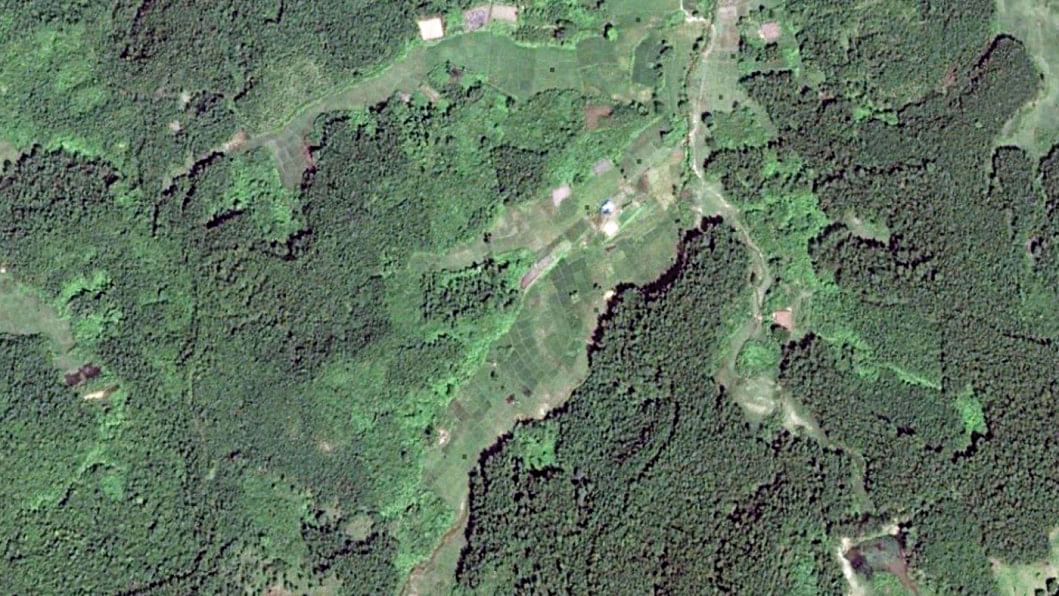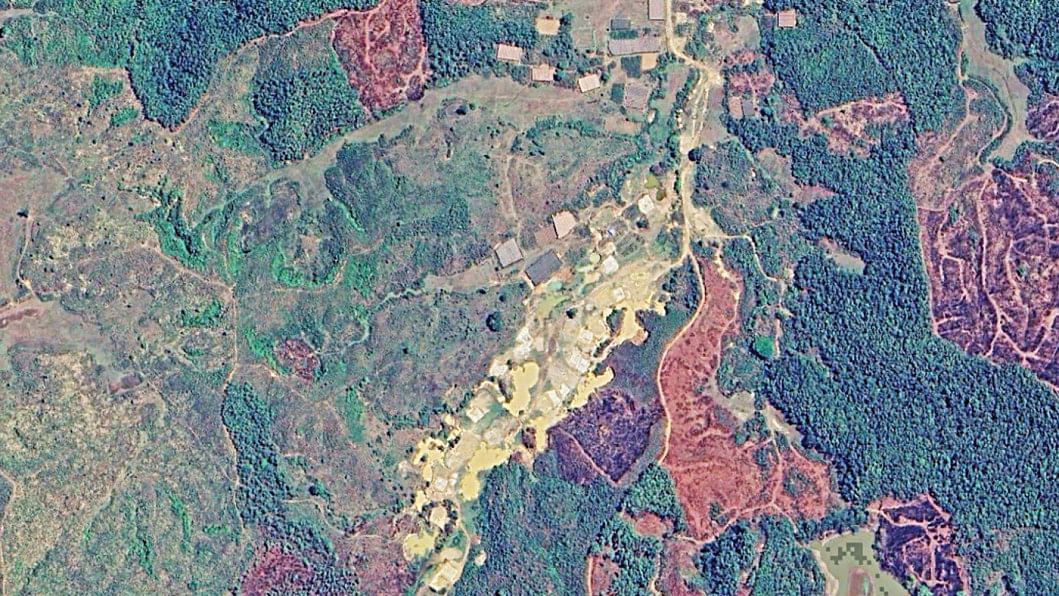Chunati Wildlife Sanctuary: So dark the greed of men
Satgar area under Chunati Wildlife Sanctuary in Chattogram used to be a lush green haven for Asian elephants.
However, it took one Abu Taher, a local influential, and his cohorts only a decade to wipe out around one square kilometre of the forest area.
His onslaught included cutting hundreds of trees, razing hillocks and lifting sand, making the area barren.
The devastation is so dire that it has put a herd of the endangered mammals at risk of habitat loss and displacement.
Lifting sand inside a sanctuary is an offence under the forest and "balu mahal" management acts.
Visiting the area recently, this correspondent observed that a lake has been formed due to illegal sand lifting in the elephant habitat, along with at least 30 other large holes. The sand lifters also destroyed at least seven hills and thousands of trees in the area.
The sanctuary, established in 1986 with nearly 7,764 hectares of land, is not only a grazing and breeding ground for Asian elephants, but also home to many other species such as deer, fishing cats, wild boars, and porcupines.

THE MAN BEHIND THE DESTRUCTION
Local UP chairman Zainul Abedin claimed that a syndicate led by one Abu Taher has been destroying the forest by lifting sand from near a canal inside the forest for five years, right under the nose of authorities concerned, including the forest and environment departments.
Contacted, Abu Taher admitted that he had earlier lifted sand from inside the reserve forest.
"Not only me, but also many people of this area often lift sand from there," he told The Daily Star. However, he claimed he no longer extracts sand from the area.
Forest department filed at least 32 cases against Abu Taher in the last decade, said Abdur Razzak, Chunati forest ranger. Abu Taher and his cohorts were arrested at least twice before, but soon walked free on bail, the forest official said.
Seeking anonymity, an official of the Chattogram South Forest Division, said forest destroyers often exploit gaps in existing forest laws, as the offense of forest destruction typically carries a nominal punishment.
Advocate Debashis Dutta, a lawyer of the forest court, said, "Perpetrators are getting away by paying nominal fines using loopholes in the law. The authorities concerned should review environmental laws to protect forests."
Environmentalists Sanjida Rahman and Mohammed Rumel echoed him.
Meanwhile, locals also alleged that some ruling party leaders are sheltering Abu Taher and his nexus of evil.
Kaiser Siddique Khan Manik, an entrepreneur of the Chunati Union of this upazila, said, "Two leaders of the ruling Awami League are sheltering them."
Mohammed Mizan, a Swechasebak League leader of this union, said, "Members of this syndicate earlier worked as day labourers in the area. But now they are living a luxurious life with money from the sale of sand, trees and soil inside the forest."
Mahmud Hossen, a forest official of Chunati Wildlife Range, said, "We failed to protect the elephant habitat from forest destroyers. But we are continuing our efforts."
Rafiqul Islam Chowdhury, divisional forest officer in Chattogram, said, "Local administration should come forward to protect biodiversity and punish the culprits through conducting mobile court drives since we do not have the authority to conduct such activities."
Contacted, Enamul Hasan, upazila nirbahi officer of Lohagara, said, "We recently conducted a drive and seized around six lakh cubic feet of sand from there. We are continuing our drives against such illegal activities."
When asked what they are planning to do to restore the forest area, he said they had formed a committee led by the AC Land in this regard.

ELEPHANTS LOSE THEIR HABITAT
A study in 2014 estimated that over 35 elephants were living in the sanctuary.
Locals and environmentalists fear that the number will be far less if a similar study is conducted now.
The impact of the damage came to light after an elephant calf died falling into a hole there in November 2022.
The depletion of forests and shrinking of habitat are also causing a rise in human-elephant conflicts in this area.
The International Union for Conservation of Nature (IUCN) marked the Chunati-Satgar area, around 2.77km in length and 0.57km in width, as a major elephant corridor in 2016.
Around 119 elephants from south Chattogram, Bandarban, and Cox's Bazar forest areas were using the corridor to migrate between their habitats.
Once a natural ecosystem for these elephants, the forest is gradually turning into a death trap for the endangered species.
This correspondent also found footprints left by a herd of elephants still living there.
Abdur Rahman, a local farmer, said he regularly saw a herd of elephants roaming inside the forest and adjacent areas.
"Once the area had a rich forest cover with thousands of trees. But sand lifters have felled all the trees and made the area barren," he said.
RISE IN HUMAN-ELEPHANT CONFLICTS
Due to their habitat loss, the elephants are compelled to invade the localities adjacent to the forest in search of food.
This has, in turn, increased the propensity for human-elephant conflicts in the area.
Sahab Mia, a local farmer, was killed in an attack by an elephant while working at his farm on December 18.
"The elephant invaded our farm and killed my brother on the spot," said his brother Altaf Mia.
At least 20 people were killed and 19 others injured in elephant attacks in the country in the last year, according to the Wildlife Management and Nature Conservation Division.
Raquibul Amin, country director of IUCN Bangladesh, said failure to protect the elephant habitat would severely impede the elephant population as the species is already endangered in Bangladesh.
Mohammad Abdul Aziz, a professor of Jahangirnagar University's zoology department and also a member of Asian Elephant Specialist Group of South Asia, said, "The habitat loss will force the herd of elephants to displace from the forest as there are no trees remaining."
"There is an urgent need to protect and augment the traditional elephant habitats to neutralise the rising trend of elephant-human conflicts, wherever feasible," he added.

 For all latest news, follow The Daily Star's Google News channel.
For all latest news, follow The Daily Star's Google News channel. 

Comments